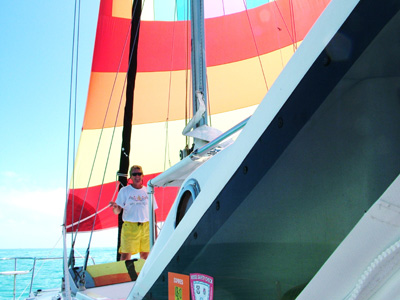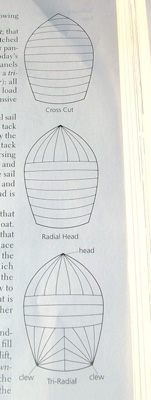

Asymmetrical Spinnaker - Gemini 105
 |
Now I just think this is a colorful sail. All of the colors of a rainbow. What was really neat was I just got the sail up and a Captain I know, Patrick, yelled at me from his charter boat and said "Hi Jim." He then called me on the radio and told me the sail was very colorful. I told him this was the first time we had ever flown an asymmetrical and we were taking pictures for everyone who reads our website. I really do like all the people in Key West because it is really such a small town and as you get to know people, you really enjoy seeing them on the water or in town. So here are the pictures and the results. We took these pictures in about 4 knots of wind and the boat was moving right at 2 knots. That was our first time up. Then the wind dropped and we motored for awhile up Key West and turned around. On the way back down I went forward and moved the lines around so we would be on a starboard tack. Then we saw some wind. It was BIG wind. 8 whopping knots. We set the asymmetrical and were making about 4 knots for a short period of time and the wind went back to 4 knots. Wow, this is going to be fun. I can't wait to fly it in 10-12 knots of wind and it is blowing steady! We took the pictures below so you can get an idea of size. That of course is me to the lower left and I am actually wearing a rainbow colored Key West shirt. Appropriate don't you think? Then the picture below was to show you how much visibility you have going forward. It is great because we can actually see boats or obstacles in front of us. This is better than our jib, too cool. In addition, you can just make out the lines that I attach the sail with. One is tied to the port cleat and the other to the starboard cleat. I still have to play with these settings because I think it will make a difference on wind angle as to their settings. Don't worry, asymmetrical theory is coming next. You know I just can't help myself. |
 |
 |
There are three different types of asymmetrical sails. The picture to the right is of symmetrical sails but the theory is the same. The sails can be constructed as cross cut, radial head, and the Tri-radial. We have the radial head and as I understand it, that is a compromise sail that is best between 140 degrees and about 70-80 degrees to the wind. Although we did fly it straight downwind and it flew pretty good. By the way, we did not have the main sail up because the wind was so light. The real question for me was, how do you size an asymmetrical? If you read the Gemini list, you would simply go out and buy a Melges 24 asymmetrical. I couldn't find one so instead, I did some research and found when shopping for a sail you really need to measure the I and J measurements (see far right picture) and then start calling used sail companies or do your searching on-line. The I measurement (from the top of the spinnaker halyard to the base of the mast) on my Gemini hull number 536 is 36.5 feet and the J measurement (from the base of the jib roller to the base of the mast) was 11 feet. Typically you want the luff to be right at or shorter than the I measurement. So I was looking for a sail with a luff of 36.5 feet down to 34 feet. This contrasts to a Melges 24 of a luff of 32 feet. The foot on an asymmetrical can but up to 200 percent of the J measurement. The sail I purchased is .75 ounce rip stock nylon with a luff of 36.5 feet which includes the sock hardware. The foot of the sail is 18 feet contrasting to 22 feet for a Melges (if the info I have is correct on the Melges) which ended up being 164 percent. The sail area is 328 square feet while the Melges would be 352 square feet. I could have looked further but the sail I found was in very good condition and priced at 450 bucks including an early model chute scoop. I got this sail from Bacon Sails in Annapolis. The closest other bid I had was 750 bucks which would have included a new model chute scoop. Since I had never flown an asymmetrical before and I was just hoping the results would be worth it. So I chose the least expensive option. I am very happy with
my choice. You never know what a used sail dealer has in stock so you
have to call all of the dealers and get the best deal. My sail has a few
small holes which were easily patched with "sticky tape." By
the way, all of this was revealed before I bought the sail and they even
sent me pictures of the sail along with the small holes for complete disclosure.
Small issues with a sail are common and I now have all the sticky tape
I need for maintenance. Since we typically do not go out in high winds,
I believe this will be a very colorful and useful addition to our boat. |
  |
|
Web Page by Jim Faughn